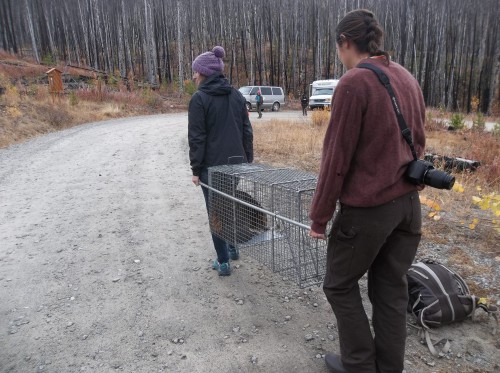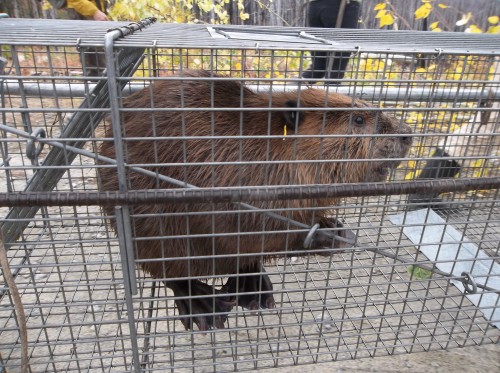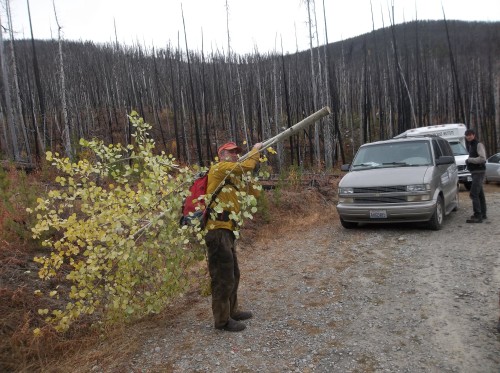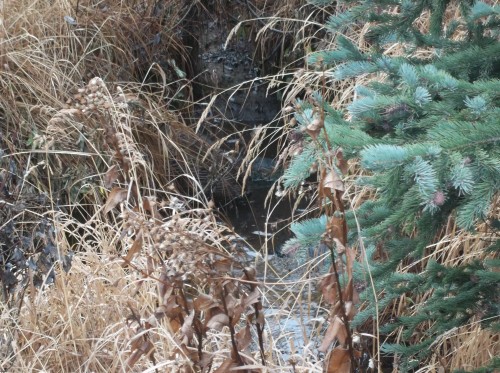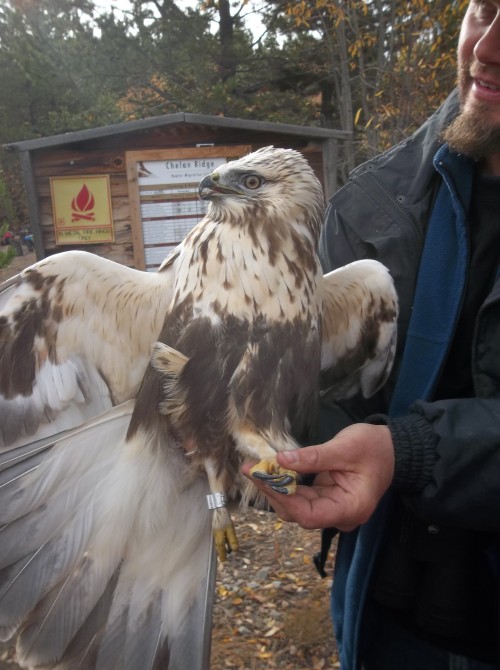Beavers and Hawks: Graduate Fall Retreat Seminar 2015
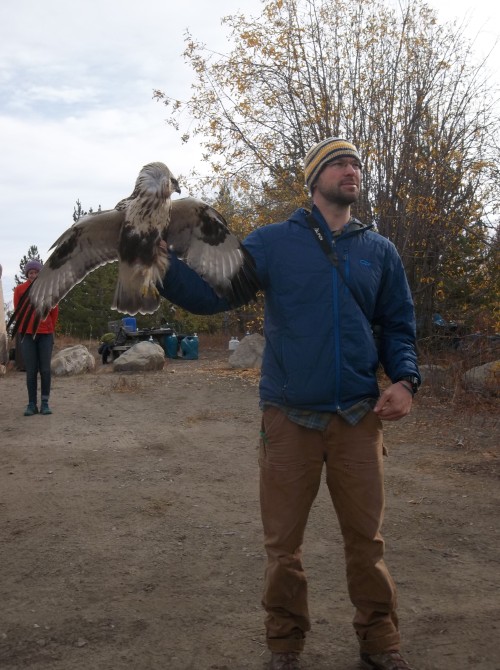
Woke up at 0555 to a pack of coyotes (Canis latrans) howling and barking in a playful manner with one another for about ten minutes. During this time a barred owl (Stix varia) was making some small hooting. Still very dark, the weather was mostly fog with a 70 yard visibility at 40*F.
This is how my journal entry for the 2015 Fall Natural History retreat started on October 8th, 2015. As part of the Graduate Program at North Cascades Institute, the fifteen of us students in the newest cohort along with our instructors Joshua Porter and Lindsey MacDonald went over to the Methow Valley to get first hand experience with our natural home. As future environmental educators, it is vital for us to understand our local ecosystem through experience so that we can lead the next generation in outdoor experiences. With this trip in particular, the first day focused on beavers, while the second on hawks.
We had spent the night in the Gardner Hut on Rendezvous Pass. When we awoke we heard a chorus of coyotes and owls, but could not see them due to two factors: low visibility due to heavy fog and little sunlight, and rather comfortable and warm sleeping bags. Despite this, we packed up, ate breakfast, and heading for Winthrop.
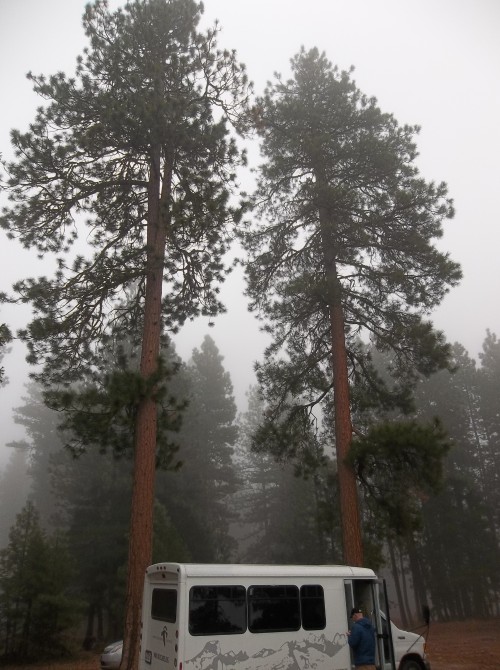
Packing up from our night in the Gardner Hut. Two Ponderosa Pine are pictured.
At the Rocking Horse Bakery in Winthrop, we met Kent Woodruff and Catherine Means of the Methow Beaver Project. Kent, who started the project back in 2009, described to us why he started this project along with the goal. The glaciers are retreating all over the North Cascades. Some of that run-off water goes into the Methow River and the water table of the Methow Valley. Since glaciers are not as large as they were historically, they are providing less water each year to the people of the valley.
Beavers were also hunted historically for their pelts all over the Northwest, some estimates are up to 90%. This affected the habitat significantly since beavers add complexity to stream systems. Stream complexity makes streams more resistant to erosion and sudden change and restores habitats to historic conditions. The beaver ponds also help to retain water in the system, which helps immensely when water levels are dropping.
By restoring the beavers to the valley, the Methow Beaver Project is restoring natural habitat, helping a population that has been devastated by past hunting, and protecting the water table in this historic time of drought and heat. All of this without adding any infrastructure and being cost effective, the project has been met with great acclaim! After we finished our conversations, coffees, and teas, we then followed Kent to where the home base of the project is.
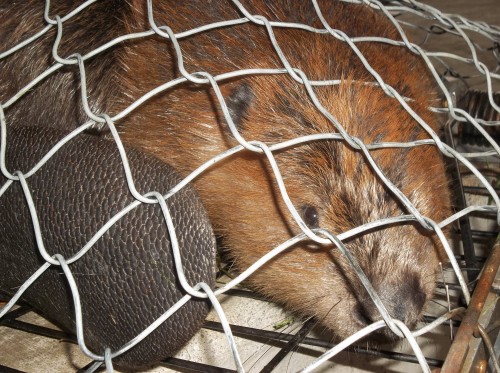
Beaver in the self designed “Beaver Trap.” This keeps handlers and the beaver safe during all transportation.
We traveled only a few miles to the Winthrop National Fish Hatchery, located of course in Winthrop, WA. Walking past all of the fish holding tanks, we were greeted to a rather large beaver being weighed by the staff. “This one was just caught last night and we think might be related to the kits we caught in the same area earlier this week.” said Cathrine. Even though there as been much acclaim about the project, most of the beavers come from local property owners calling for the beaver removal. Instead of killing the beaver, however, the Methow Beaver Project takes these beavers off of owner’s properties and onto natural public land where they can live out their lives in peace.
To protect the handlers and beavers, the beavers are caught in 4’x4′ cages. This assures that the beavers have just enough room to be comfortable, but not enough room to hurt themselves while trying to escape. The staff then take the beaver from the “catching location” to the fish hatchery where a battery of tests are done before it can be put in a more comfortable home.
On the list of tests were weighing, scanning for tags, taking a DNA hair sample, and “sexing” the beaver. Our beaver (which was a rather large one) was 50 lbs! They then scanned the tail for any microchips, to see if they had already tagged this beaver before. This simple tracking is done so that they can see if beavers are staying where placed or moving to new locations and being recaptured. Next, a hair sample is used to see how healthy the beaver is overall.
Unlike humans, beavers’ sexual organs are located on the inside of their body which makes determining the sex (or sexing) beavers quite difficult. As Kent explained, “Traditionally people took a blood sample from the beaver and sent it to a lab which only had a 70% success rate at sexing beavers. We found out however that a particular oil gland used for scents differs greatly between genders: males smelling like motor oil and females smelling like stinky cheese. In just a few minutes we can determine the sex with 99% accuracy. The best part? It causes less stress to the beavers.”
After they collected their sample, and with the smell of motor oil in the air we all yelled “it’s a boy!” The next very important step was to name him. It took the whole day, but we finally decided on Don Julio.
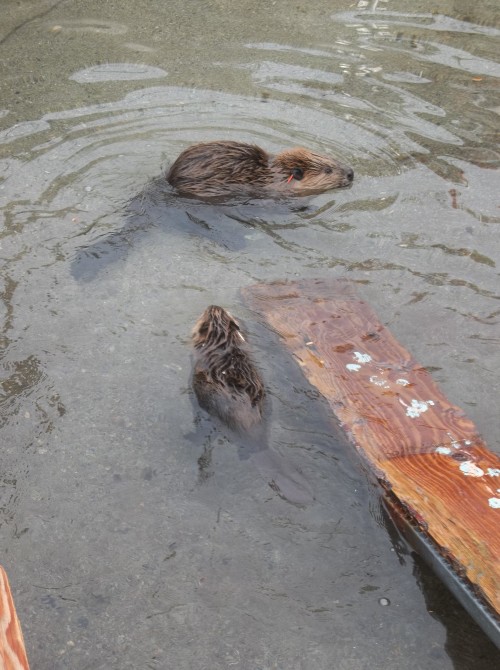
Don Julio being reintroduced to one of his kits.
Now that Don was finished with his tests, the staff released him into a old fish holing track repurposed for beaver use. This particular track had three kits that the staff thought were the Don’s offspring. We all waited patiently to see how they would react.
After a little bit the first kit came out to see “dad.” It took about five minutes for them to be comfortable around one another but after that the kit was following dad wherever he went! The other two were not as brave and just wanted to stay in their room.
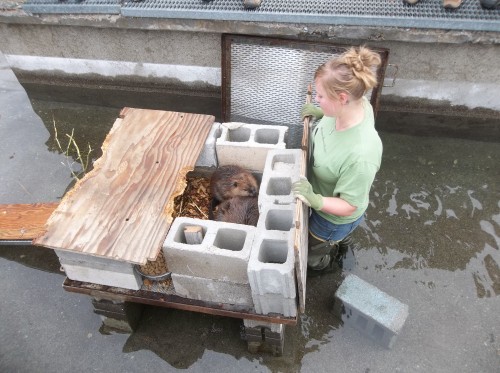
Two kits being encouraged to leave their room and be reintroduced to their father.
“We would love to get the whole family back together, so we will set up more traps tonight for the mom. Relocation has a much higher success rate if the whole family is together” Kent replied when we asked about the mom.
Our next task was to relocate two other beavers to their new home. The pair, Rinka and Septimus, were to be placed at the Burn Heart mining trail site. The area had been affected by fires in recent years and having a pair of beavers would help restore the area much more quickly. We helped the two love beavers into separate litters and took them to the trail head.
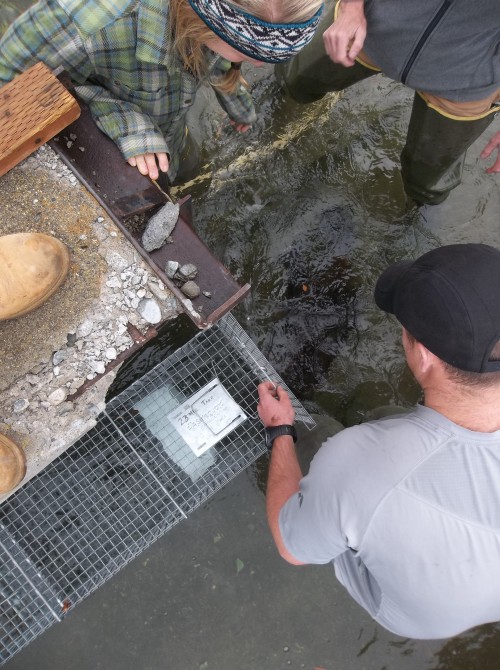
Emily Ford and Rob Healy helping Septimus into his litter.
Annah Young and Hannah Newell carrying Septimus to his new home.
Rinka enjoying the spotlight!
Our own Joshua Porter carrying a snack as a house warming gift for Rinka and Septimus.
After a short hike with Rinka, Septimus, and snacks of Yellow Aspen in hand we came upon a large structure. “We built this as a safe place for the beavers to start. They will eventually move out and build their own home but this is at least a place for them to start” Catherine explained. After putting their snacks in place, we let them into their new home and waited. We wanted to make sure that they could find their snacks and water supply. We also really wanted to see them enjoy their new (temporary) home!
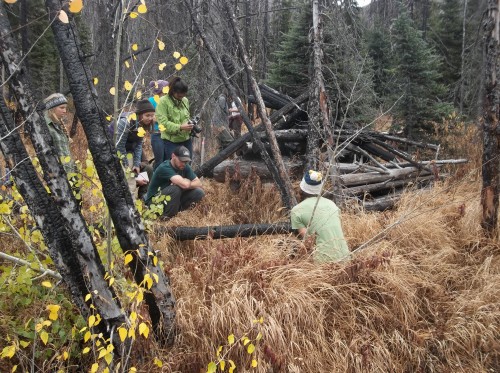
Waiting patiently around their new home. Yellow Aspen “snacks” are located in the lower left of the picture.
One of them is enjoying the river! (Very center of picture)
After five minutes, we saw one of them go into the river! Wanting to give them space, we left and headed back along the trail. The staff then took us to a success site, where we got to see how well the beaver pond restores the riparian zone. And that was only after a few weeks! We then bid them goodbye and headed up to Chelan Ridge, where Hawk Watch was waiting for us.
We drove for about an hour to the top of the ridge where we met Jesse Watson and his crew of wildlife biologists. While they work for the US Forest Service, they have partnered with Hawk Watch International to track the hawks flying through the Pacific Coast Flyway.
The mission statement describes their purpose clearly: “The mission of HawkWatch International is to conserve our environment through education, long-term monitoring, and scientific research on raptors as indicators of ecosystem health.” By monitoring the raptors over the long term, they can assess the total ecosystem health in places all around the world. All of the teams in each region send the data that they see into one global database.
One of those teams is lead by Jesse on Chelan Ridge. We shared dinner, swapped a few stories, and went to bed before a long day on the ridge.
When we awoke Jesse and his crew described to us the four different families of raptors that we could be seeing today:
- Accipiters: Long tail: Short, wide wings; flap, flap, sail wingbeats. Goshawks are a prime example.
- Buteos: Broad wings and short, rounded tail; commonly seen soaring. Red tailed hawks are the buteo you will see the most.
- Falcon: Pointed wings; long, tapered tail; rowing wingbeats.
- Eagle: Large; soars on long, rounded wings.
Jesse holding a recently captured Rough-Legged Hawk, a Buteo Hawk.
In the middle of this explanation of hawks, Jesse was brought a Rough-Legged Hawk that one of his staff just captured to tag. Not only does HawkWatch monitor raptors, but they also tag to record where they have been. Just like the beavers, this is done to see where all they have been. Jesse’s staff is extremely efficient with capturing, tagging, and releasing. HawkWatch international suggests 40 minutes between capture and release as to not stress the birds too much. Jesse’s team gets it done in 20.
After we had all taken pictures of the hawk, Jesse asked if anyone would like to release it back into the sky. Zachary Lundgren (pictured in the cover photo) stepped up. He positioned himself and the raptor so that they were facing the wind to give it the best chance of flight. As he threw it into the air, the bird opened its wings and landed on a tree nearby.
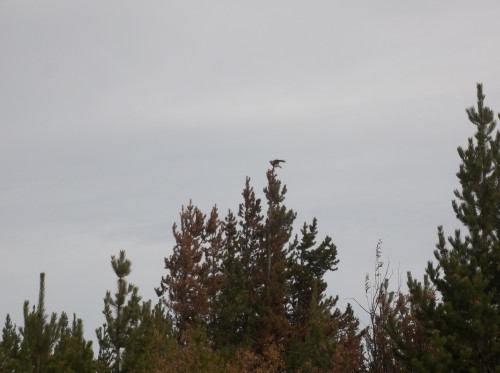
Our rough-legged hawk resting after just being released.
Our spot for the rest of the day, however, was not in the forest, but high up on the ridge. We hiked a mile to the top where we could see for miles around. With the wind howling we were taught the proper way to use binoculars and spotting scopes. We then spent the next few hours just observing the hawks passing through.
For at least two days, the 15 of us got to learn about two local, important animals through these amazing experiences. I can’t wait until it is my turn to take a group of students to places just as amazing as these.
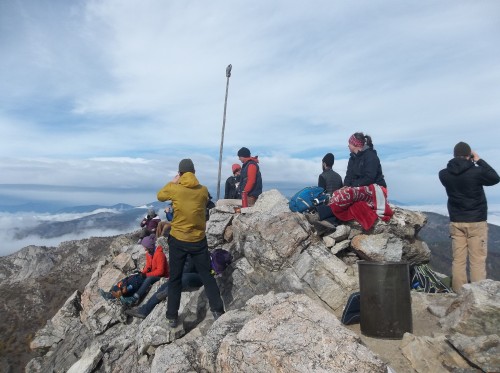
Looking for hawks passing through.
Both the Methow Beaver Project and HawkWatch Chelan ridge are scientific organizations that also focus in environmental education. If you have any questions or want to visit either of them, don’t hesitate to contact them.


